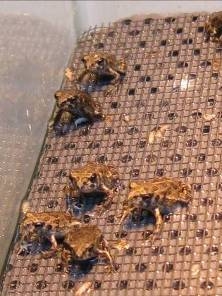
At around six weeks, the toadlets look like miniature (half-inch) versions of the adults. (Courtesy of Cheyenne Mountain Zoo)
A North American toad is fighting its own battle with chytrid, a battle just as devastating as the one frogs in Panama are facing. The Wyoming toad (Anaxyrus baxteri) is one of the most endangered anurans (frog or toad) in North America. Historically, they were found in the Laramie Basin of southern Wyoming. Up until the mid 1970s, they were common throughout this region, but since then, the population drastically declined. Major threats are loss of habitat, pesticide usage and chytrid fungus. In 1994, the last wild toads were rescued from extinction when they were collected and sent to a captive breeding facility. One day, their tadpoles could be released back into the wild, thanks to Cheyenne Mountain Zoo (CMZ), and other zoos and federal facilities now breeding Wyoming toads.
The CMZ Amphibian Propagation and Research Center is a bio-secure area and closed to zoo guests to help keep chytrid fungus and other diseases out of the breeding population. CMZ’s Wyoming toad population for 2011 consists of 17 males and 17 females. However, due to limited space for tadpoles, not all of the toads are bred each year. The Wyoming toad studbook keeper and population manager determine what the best matches are to maximize and maintain genetic diversity. CMZ also monitors the overall health of each toad and decides whether they are fit for reproduction.
During most of the year, CMZ’s goal is to keep the toads healthy and growing with exceptional water quality, properly supplemented feeder insects and regularly changed UV bulbs. As spring approaches, we confirm our recommended pairings and prepare for something somewhat disconcerting for an animal keeper–we have to chill our toads in the refrigerator! In order for them to breed successfully, the toads require a period of cool hibernation as would be experienced in the wild. This is a very delicate time for them because their immune systems are suppressed.

Cheyenne Mountain Zoo's Wyoming toad room in the Amphibian Propagation Center. (Courtesy of Cheyenne Mountain Zoo)
A few days prior to hibernating, the toads are not given food. As their metabolism slows, so does their digestive tract, and undigested food could make them sick. Their room is slightly cooled from 75 degrees to 65 degrees and the lights are turned off the day before entering the hibernaculum, which is basically a fancy refrigerator. Each tank of toads has its own tub filled with wet gravel, carbon, sand and moss. The toads are weighed, placed in the tubs and the temperature is set to 52 degrees. The next day, it’s turned down to 45 degrees, the following day to 41 degrees and finally, down t
o a chilly 38 degrees. The toads will remain at this temperature for 35 days, misted with chilled water to maintain humidity and checked on about twice a week. We have to limit the number of checks to reduce the amount of environmental disturbance.
After 35 days, the toads are slowly warmed up in reverse order of the cool down. It’s believed the hibernation helps produce the natural hormones that would trigger reproductive behavior in the wild. The toads are placed back in their normal husbandry tanks and offered a few insects. They should be ready for breeding the next day.
Many species of amphibians are not able to be bred in a captive environment. For the Wyoming toad, it was discovered they require supplemental hormones in addition to hibernation in order to reproduce. The females are given their first hormone injection in the morning and placed in a breeding tank. Six hours later, the males are given a hormone injection and the females their second. The breeding tank has about one-and-a-half inches of water and some plastic floating plants. A recording of Wyoming toad breeding calls is played for 24 hours while the pairs are together. (Hear a sample of the Wyoming toad call) By the next morning, the female should have hopefully produced eggs fertilized by the male.
On June 1, 2011, six pairs of Wyoming toads were placed together at CMZ, and all of them produced eggs! Unfortunately, two of the egg masses were infertile, but in total, CMZ had about 2,000 tadpoles. 1,792 of them were released back into the wild in Wyoming. Based on valuable genetics, CMZ held back 60 tadpoles for future breeding.
Each year, staff from CMZ, other zoos and U.S. Fish and Wildlife Service survey Mortenson National Wildlife Refuge for offspring from previous released Wyoming toads. This is a non-public access refuge, and reintroductions were stopped at this site in 2005 due to chytrid. The site allows us to see if the population could continue even though chytrid was present. Tadpoles are now released at a different location, which prevents us from confusing recently released animals with those naturally produced in the wild.
Length, relative size, weight, habitat conditions, temperature and wind speed are just some of the data recorded during the survey. Most importantly, though, is collecting a swabbed sample from each found toad to see if chytrid is present. The toads are also given a microchip under their skin for permanent identification, enabling us to know how many different toads are found. If a microchipped toad is caught again, a scanner will tell us.
Cheyenne Mountain Zoo is very proud to be an important participant in the Wyoming toad recovery program!
–Jeff Baughman, Conservation Center keeper, Cheyenne Mountain Zoo

